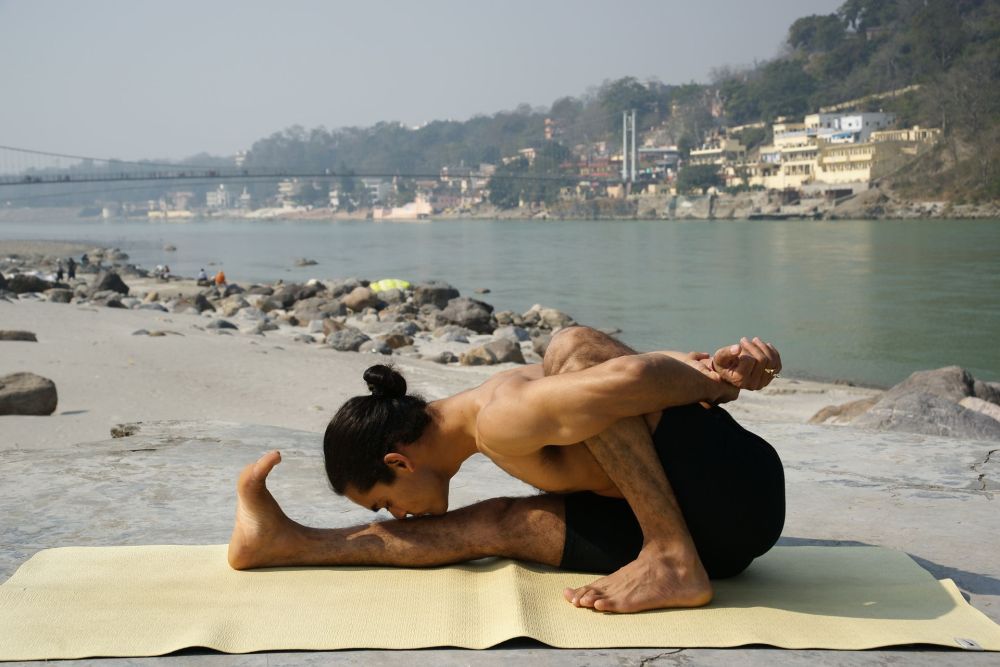
The benefits of ashtanga yoga for weight loss are numerous. Ashtanga Yoga is one of the most popular yoga styles. It offers an intense physical workout that helps you lose weight effectively.
Ashtanga Yoga involves strength-training and muscle-building exercises. It helps you feel energetic and think positively on your journey to your dream body.
Ashtanga Yoga is also very spirited and fast-paced. It improves energy levels, health, and overall physique. It promotes well-being, emotional, and spiritual balance.
Let's look at what Ashtanga Yoga is and how it helps you reach your body goals.
Panaprium is independent and reader supported. If you buy something through our link, we may earn a commission. If you can, please support us on a monthly basis. It takes less than a minute to set up, and you will be making a big impact every single month. Thank you!
The origin of Ashtanga Yoga

Ashtanga Yoga translates as eight-limbed Yoga. It's a very ancient and proven type of yoga. It was popularized by Indian Master Sri K. Pattabhi Jois during the 20th Century.
Ashtanga Yoga is a path of purification and self-discovery. It contains the following eight internal and external cleansing practices:
- Yama or moral and ethical guidelines
- Niyama or self-purification and learning
- Asanas or postures
- Pranayama or breathing exercises
- Pratyahara or control of sense
- Dharana or focus and concentration
- Dhyana or meditation
- Samadhi or absorption into the Universal
Some classes mainly focus on physical practice. But, to fully benefit from Ashtanga Yoga, it's important to tackle all eight aspects. Any serious practice includes physical, mental, and spiritual exercises.
These eight steps lead to a meaningful and purposeful life. This method of yoga involves a precise and progressive series of poses in sequential order.
Ashtanga Yoga is also known as Ashtanga Vinyasa Yoga. It's a highly structured vinyasa-style class including a rigorous and intense yoga practice made of six series.
Each student must master every pose of one series before moving on to the next. Each one becomes progressively harder in a very dynamic style of practice where poses aren't held for very long.
Ashtanga Yoga is a very difficult and strict practice. It's very unique due to the strict adherence to the routine. Each pose is meant to prepare the body, mind, and spirit for the next sequence.
What an Ashtanga Yoga practice looks like
An Ashtanga Yoga practice usually starts with five repetitions of Surya Namaskar A and B, also known as Sun Salutations. It's then followed by 6 standing poses and one of the following six series:
- First series: Primary series.
- Second series: Intermediate series.
- Third series: Advanced A.
- Fourth series: Advanced B.
- Fifth series: Advanced C.
- Sixth series: Advanced D.
An Ashtanga Yoga practice ends with a closing sequence, usually a set of inversions and seated poses.
Below, you can find a video of Pattabhi Jois teaching the Primary series. The students shown in this video are very advanced. With patience and commitment, you will be able to do it too!
Coordinating your breath and movements carefully is essential throughout an Ashtanga Yoga practice. Each pose requires a specific set of inhalations and exhalations.
An Ashtanga Yoga class may not burn many calories but it makes you sweat. It also strengthens and lengthens your muscles to help you feel refreshed and invigorated after practice.
The Ashtanga Yoga benefits include building a strong, flexible, toned, and fit body.
Is Ashtanga Yoga suitable for beginners?

Ashtanga Yoga is a tough type of yoga. Beginners should practice the basics of yoga before getting into an Ashtanga practice.
Mysore style Ashtanga is accessible to everyone. It comes from the city Mysore, in Karnataka, India.
Students are guided one on one by the teacher. They learn to practice postures correctly. There is an emphasis on adjustments in Mysore classes. The practice is adapted to the students' needs.
After regular and successful Mysore practice, you can move on to a guided Ashtanga Yoga class.
This type of yoga is for you if you want a challenging style of yoga. If you like routine and structure, it might be a good choice for you. But note that Ashtanga Yoga requires a lot of stamina, strength, agility, and flexibility.
Ashtanga Yoga benefits include improving physical and mental strength. But it isn't suitable for everyone. Less intense practices such as Hatha Yoga or Iyengar Yoga may be a better choice when starting yoga.
The goals of traditional Ashtanga Yoga

The purpose of Ashtanga Yoga is the purification of the body and mind. Ashtanga Yoga places a strong emphasis on growth and progress during practice.
This type of yoga combines breath, movement, and focus. Practitioners need to find a balance between body, mind, and spirit as well as improve their strength and flexibility.
Ashtanga Yoga focuses on muscle training, providing powerful weight management, and strength-building routines. It also calms the mind and brings inner peace.
Ashtanga Yoga benefits everyone, even athletes looking to increase their overall performance. Ashtanga classes are quite fast-paced. They increase stamina and endurance.
Practitioners use their entire body weight to become stronger and leaner. Ashtanga Yoga is also a great way to improve focus and relieve stress.
It elevates spiritual consciousness, enhances memory, relieves headaches, and makes you feel replenished, relaxed, and calm.
With a progressive series of postures, Ashtanga Yoga produces intense internal heat. It purifies the body internally, including muscles, and organs.
Its benefits include improved overall health, a stronger body, and peace of mind.
Ashtanga Yoga benefits for weight loss

Ashtanga Yoga offers numerous physical, mental, and spiritual benefits.
Its benefits include improving your health and well-being, increasing your disease resistance and immunity, making your body more flexible, stronger, and leaner.
Ashtanga Yoga also improves your focus and concentration, mindfulness, and self-awareness. It reduces stress and anxiety, promotes wisdom, gratitude, acceptance, and compassion.
Practice it often to reap its many amazing benefits for the mind, body, and spirit. You can practice Ashtanga Yoga every day if you alternate between intense and lighter days.
Consistent and regular practice helps you get stronger, more flexible, lose weight, and find inner peace while releasing any tension, strengthening muscles and joints, and massaging internal organs.
To sum up, some of the benefits of Ashtanga Yoga include:
- Burns lots of calories, enough to lose weight.
- Builds strength, flexibility, and stamina.
- Boosts metabolism and calorie burning.
- Increases focus and concentration.
- Relieves stress and tension.
- Helps calm down and relax.
- Provides restful deep sleep.
- Strengthens joints, ligaments, and nerves.
- Promotes weight loss and fat burning.
- Improves overall blood circulation.
- Decreases cholesterol and blood sugar levels.
- Balances hormone production.
- Reinforces the immune system.
- Promotes healthy digestion and detoxification.
- Regulates blood pressure.
- Calms the mind and promotes mental clarity.
- Improves mindfulness and self-awareness.
- Teaches self-acceptance and wisdom.
Practice regularly to feel motivated, see progress, and lose weight. Combine Ashtanga Yoga with a healthy yoga diet for the best results.
Ashtanga Yoga helps you become more aware of your body, thoughts, and emotions. It gives you the tools to find balance and follow a healthier lifestyle.
Ashtanga Yoga makes you aware of some habits you may have that aren't serving you.
Listen to your body closely to prevent any pain and injury. And practice at least 6 days a week.
You can seek the assistance of a good yoga teacher in the beginning. It's a lot easier and safer to learn with personal attention, guidance, corrections, and precisions.
Remember to move at your own pace and don't push yourself too hard in the beginning.
Was this article helpful to you? Please tell us what you liked or didn't like in the comments below.
About the Author: Alex Assoune
What We're Up Against
Multinational corporations overproducing cheap products in the poorest countries.
Huge factories with sweatshop-like conditions underpaying workers.
Media conglomerates promoting unethical, unsustainable products.
Bad actors encouraging overconsumption through oblivious behavior.
- - - -
Thankfully, we've got our supporters, including you.
Panaprium is funded by readers like you who want to join us in our mission to make the world entirely sustainable.
If you can, please support us on a monthly basis. It takes less than a minute to set up, and you will be making a big impact every single month. Thank you.































0 comments